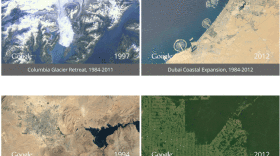More than 7,000 square miles of land in the Great Lakes region changed in some way from 1996 to 2010. That’s roughly equal to the surface area of Lake Ontario.
That’s according to a new report from the National Oceanic and Atmospheric Administration.
Researchers at NOAA used satellite maps to study our cities, forests and wetlands. Not surprisingly, they found most of the development during that time period happened around our big cities: Chicago, Detroit, Grand Rapids and Milwaukee.
Nate Herold is with NOAA’s Office for Coastal Management. He says they also found a net loss of forest land in the region.
“What we typically end up seeing with forest is there’s a lot of change, but it doesn’t necessarily equate to a loss in forest land.”

He says a lot of these areas are managed for timber harvest and they eventually grow back.
Some highlights from the report:
The Great Lakes region experienced a net loss of 1,735 square miles of forest cover (2,773 square miles of forests were cut while 1,038 square miles of forest were regrown). Many of the region’s forested areas are undergoing transitions that do not result in permanent loss. Coastal counties added over 1,259 square miles of development, an area larger than the cities of Chicago, Indianapolis, Detroit, Columbus, and Milwaukee combined. The region lost 150 square miles of wetlands over 15 years, but 218 square miles of wetlands were gained, representing a net gain of 68 square miles of wetlands present in 1996. Wetlands lost were largely due to development around Chicago, Cleveland, and Buffalo. Low water levels, such as those seen around Saginaw Bay, Michigan, dominate the areas of wetland gains.




